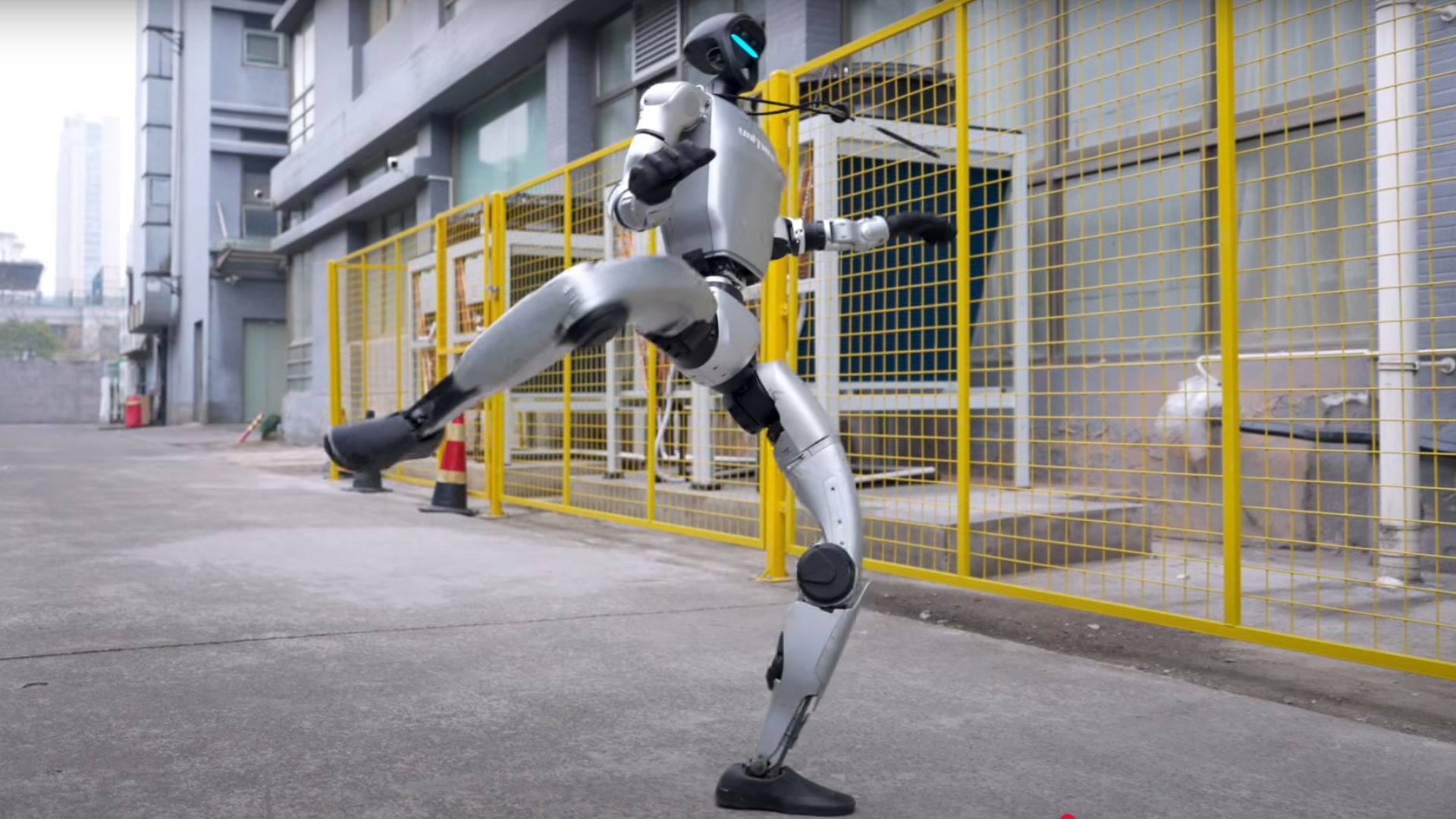- Vision Quest
- Posts
- This Week in Tech 62
This Week in Tech 62
AI copy of YouTube CEO scams users, RIP Skype and Unitree's robot can now fight like Jackie Chan
Welcome to the cutting edge ⚔️
Read time: 7 min
Today’s Slate
Mobile World Congress 2025 announcements from Barcelona
Cyborgs inch closer with the first synthetic biological intelligence that runs on human cells
AI used to impersonate the YouTube CEO in latest scam on users
The Viverse from HTC is live in your Browser
RIP Skype, it’s been real
Unitree’s humanoid robot can now kick your ass - with kung fu
The. Future. Is. Here.
Mobile World Congress 2025
At a glance
New smartphone innovations: MWC 2025 showcased major phone releases, including the Nothing Phone 3A and 3A Pro with AI-powered organization features and Xiaomi’s 15 Ultra with a massive camera array.
AI-integrated mobile devices: Deutsche Telekom introduced an AI-powered “app-less” phone with Perplexity Assistant, capable of booking services and managing tasks via voice commands.
Foldable and futuristic tech: Lenovo unveiled concept devices like the ThinkBook Flip with an extra-tall folding display and a glasses-free 3D laptop controlled by an AI-powered ring.
Wearable and audio advancements: Xiaomi launched the Buds 5 Pro, the first earbuds with Qualcomm’s Wi-Fi streaming technology, and HMD introduced Amped Buds with a charging case that doubles as a phone power bank.
Concept devices and bold designs: Samsung and Tecno showcased ultra-slim phones and tri-fold devices, while Infinix demonstrated solar-powered phone charging concepts.
Expanded AI and software support: Honor committed to seven years of Android OS updates, matching Samsung and Google, while Google announced Gemini Live screen-sharing and AI-powered enhancements.
Our vision
MWC 2025 highlights how AI and emerging technologies are reshaping mobile devices, pushing boundaries in form factor, functionality, and connectivity. From AI-powered assistants to foldable displays and solar-powered concepts, the industry is accelerating toward a future where smartphones become more intelligent, adaptable, and deeply integrated into everyday life.
Artificial Intelligence
At a glance
Breakthrough AI-biology fusion: The CL1 is the first commercialized "biological computer," combining human brain cells with silicon hardware for a new form of Synthetic Biological Intelligence (SBI).
Faster, more efficient learning: The neural networks adapt dynamically, outpacing traditional silicon-based AI in speed, efficiency, and flexibility.
Remote access & cloud integration: Users can buy the CL1 or access it via "Wetware-as-a-Service" (WaaS), allowing researchers to interact with living neural networks from anywhere.
Potential for medical breakthroughs: SBI could revolutionize drug discovery, disease modeling, and treatments for neurological disorders by mimicking real brain activity.
Ethical & regulatory oversight: Strict compliance measures ensure responsible use, with ongoing discussions about the ethical implications of synthetic intelligence.
Future goals: Cortical Labs is working toward creating a "Minimal Viable Brain" to further refine AI-human neural interactions.
Our vision
Cortical Labs' CL1 introduces a new era of AI, where living brain cells integrate with silicon to create adaptable, energy-efficient intelligence. This hybrid system could transform industries by providing new ways to study brain function, test drugs, and even rethink robotics. While still in its early stages, SBI has the potential to surpass traditional AI in key areas, offering a more natural approach to machine intelligence.
At a glance
AI-powered phishing scams: Scammers are using AI-generated deepfake videos of YouTube CEO Neal Mohan to trick creators into giving up their credentials.
Fake private video messages: The scam involves sending private YouTube videos claiming to announce monetization policy changes, luring users into clicking malicious links.
Impersonating official channels: Phishing emails appear to come from "Notification for YouTube Creators" or "Channel for Creators," sometimes even using [email protected].
Exploiting in-platform features: Attackers leverage YouTube’s private video-sharing system and fake DocuSign agreements to make scams look legitimate.
YouTube’s official warning: The company emphasizes that it will never contact users or share policy updates via private videos—any such message is a phishing attempt.
Our vision
AI-powered scams are evolving rapidly, using deepfake technology to impersonate executives and deceive users with increasingly convincing phishing attempts. This latest example highlights how generative AI is changing the landscape of internet fraud, making scams more sophisticated and harder to detect. As AI tools become more accessible, platforms must implement stronger security measures, and users need to stay vigilant against these emerging threats.
At a glance
AI is redefining online experiences: Major players like OpenAI, Google, and Microsoft are rapidly evolving AI assistants (e.g., Gemini, Copilot, and ChatGPT-4o), making them more integrated into everyday workflows.
AI-generated content and misinformation risks: News organizations like the LA Times are implementing AI-generated summaries and bias detection tools, while concerns over AI-generated deepfakes and hallucinations continue to grow.
Industry shifts and competition: Elon Musk’s Grok-3 is challenging OpenAI’s dominance, while DeepSeek’s rapid rise in AI models has disrupted the market. Companies are also racing to integrate AI into search engines, personal assistants, and chatbots.
AI in specialized fields: Microsoft launched Dragon Copilot for healthcare, enhancing medical documentation through voice and ambient listening AI. AI is also being used in customer service for real-time accent translation.
Legal and ethical challenges: AI-driven lawsuits, such as copyright infringement claims against Cohere and Thomson Reuters' legal battle over AI training data, highlight ongoing concerns over content ownership and fair use.
AI in search and productivity: Google’s Gemini now assists in spreadsheet analysis, Microsoft is refining its AI-powered Copilot, and ChatGPT removed its login requirement for search, competing directly with Google and Bing.
Our vision
AI is fundamentally reshaping the internet, from how we search for information to how businesses operate and interact with users. As AI becomes more embedded in search engines, chatbots, and professional tools, ethical concerns, misinformation risks, and competitive pressures will continue to drive its evolution.
Spatial Computing
At a glance
Web-Based VR: HTC’s Viverse Worlds runs in any browser via WebXR, eliminating app downloads and working on any VR headset, PC, or mobile device.
Instant Access vs. Competitors: Unlike VRChat, Horizon Worlds, Rec Room, and Roblox, which require apps, Viverse Worlds enables one-click VR entry via a URL.
Easy World Creation: Build virtual spaces using Viverse Create or PlayCanvas, with Sketchfab asset support for seamless 3D integration.
Advanced Streaming: Polygon Streaming and Gaussian splats power high-fidelity 3D models that run on any device.
Competitive Edge:
VRChat: Requires Unity knowledge and an app.
Horizon Worlds: Has browser access in 2D, but needs an app for VR.
Rec Room: Simple tools but limited external assets.
Roblox: Supports VR on Quest but is primarily flatscreen.
Our vision
HTC’s Viverse Worlds introduces seamless, app-free VR access, setting it apart from competitors like VRChat, Horizon Worlds, and Rec Room, which require dedicated apps. By enabling instant entry via a web browser on any device, it lowers barriers to metaverse adoption. As web-based VR matures, expect a shift toward more open, cross-platform virtual worlds, challenging the dominance of closed ecosystems like Meta’s Horizon Worlds and positioning browser-based VR as the future of social and immersive experiences.
The Toronto Raptors are training at the ASB GlassFloor Athletes Lab in Orlando and I got to say, the technology is MINDBLOWING.
Using LED lights to change to any court you want (even the NBA Cup courts), to drawing up X’s and O’s that show up on the court. 😳
Future is here.
— Omer Osman (@OmerOsman200)
3:27 PM • Mar 4, 2025
No more Skype
At a glance
Microsoft is shutting down Skype on May 5th, 2025, urging users to migrate to Microsoft Teams, where their chats and contacts will be transferred automatically.
Skype’s calling features are being discontinued, meaning users will no longer be able to call domestic or international phone numbers.
Teams will be Microsoft’s sole consumer communication platform, replacing Skype after years of declining usage and competition from Zoom, WhatsApp, and FaceTime.
No immediate layoffs are planned, as the Skype and Teams teams have already merged, with employees focusing on enhancing Teams and AI-driven features.
Our vision
Microsoft is betting on Teams as its all-in-one communication platform, streamlining messaging, calls, and collaboration in both personal and professional settings. By retiring Skype, the company is acknowledging shifting user behaviors, where VoIP calling is largely replaced by app-based messaging and video platforms. This transition also reflects a broader industry movement towards AI-enhanced communication, where Teams can leverage Microsoft’s AI investments for smarter collaboration and productivity. Ultimately, Skype’s sunset marks the company’s pivot toward a unified, AI-powered ecosystem that blends work and life seamlessly.
Robotics
At a glance
Dynamic Performance: Unitree’s G1 performs 360-degree somersaults, punches pretending it’s Jackie Chan, Bruce Lee or Jet Li.
Constant Algorithm Updates: This won’t be the last update and demonstrates the continued progress they are making on the software component of their humanoid robot.
Terminator Vibes: The demonstration ends with a warning that users (humanoid robot owners?) should not actually teach it combat techniques.
Our vision
This latest update is a testament to the rapid progress humanoid robots as an industry is making. We’ve covered Unitree in previous editions and it was about the robot learning to dance, but now it can kick your ass - followed by a victory dance. While it’s exciting to watch this progress and think about purchasing a 4-foot tall humanoid to fold my laundry it does make me worried about where we go from here.
We are compressing progress down from decades and years to months and weeks. It’s hard to keep up and anticipate how long the next breakthrough will be in various industries like humanoid robotics. Regardless we’ll be here covering it all and letting you know when Unitree’s robot has a permanent residence in our house as a bodyguard, butler and takes out the trash.
New robots join the mix
Santa Clara, California-based Dexmate introduced Vega, their first general-purpose robot, developed in under six months.
Vega has an omni-directional wheeled base and an adjustable height ranging from 2'2" to 7'2".
MSRP: $90K – accepting pre-orders.
— The Humanoid Hub (@TheHumanoidHub)
7:04 AM • Mar 4, 2025
Something extra
Fascinating visual representation of morse code
— Interesting As Fuck (@interesting_aIl)
8:02 AM • Mar 2, 2025
How did you like this week's edition? |
Try Artisan’s All-in-one Outbound Sales Platform & AI BDR
Ava automates your entire outbound demand generation so you can get leads delivered to your inbox on autopilot. She operates within the Artisan platform, which consolidates every tool you need for outbound:
300M+ High-Quality B2B Prospects, including E-Commerce and Local Business Leads
Automated Lead Enrichment With 10+ Data Sources
Full Email Deliverability Management
Multi-Channel Outreach Across Email & LinkedIn
Human-Level Personalization








